
Red wines are a little intimidating. They come in such a divergent range of profiles and flavors, that it’s no wonder you can stand in front of an isle of 100 different wines and decide it’s better to walk away empty handed.
A good red wine for beginners helps you learn about different grape profiles. Try Pinot Noir, Grenache, Malbec, Merlot, Zinfandel, Cabernet Sauvignon. These six wines are the best beginner red wines. They will help you tease out the three key style choices in red wine: body, tannin, and sweetness.
Before we get into the actual wines, it’s helpful to have a breakdown of different red wine styles so that you know what to expect in the bottle. So, here’s what you need to know about picking a good red wine for beginners.
What’s a Good Red Wine For Beginners?
- 3 Red Wine Style Factors: Body, Tannin, and Sweetness
- What’s Body In Wine?
- What Is Tannin in Red Wine?
- What’s Sweetness in Wine?
- Why Red Wines with Sweetness Are Good for Beginners
- What’s a Good Red Wine for Beginners?
- A Good Red Wine for Beginners #1 – Pinot Noir
- A Good Red Wine for Beginners #2 – Grenache
- A Good Red Wine for Beginners #3 – Malbec
- A Good Red Wine for Beginners #4 – Merlot
- A Good Red Wine for Beginners #5 – Zinfandel
- A Good Red Wine for Beginners #6 – Cabernet Sauvignon
- Final Thoughts: What’s a good beginner red wine?
3 Red Wine Style Factors: Body, Tannin, and Sweetness
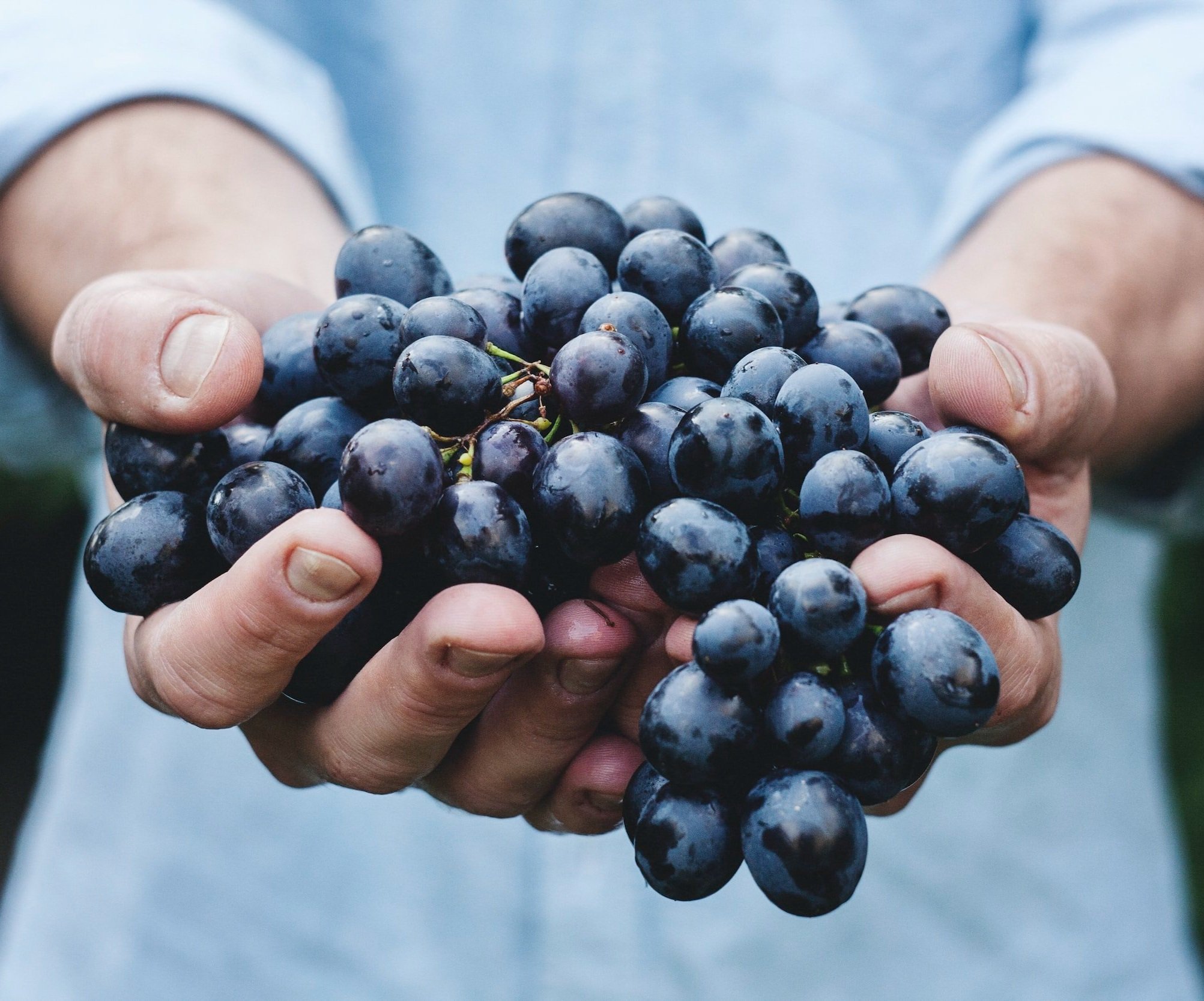
Every wine, including red wines, has a profile – a series of characteristics that makes up your sensory experience when sipping. These include the aromas and flavors, hue, acid, tannin, alcohol, sweetness (or dryness), body, intensity, and finish.
To keep things simple, you need to know about three different structural components in your red wine – body, tannin, and sweetness.
What’s Body In Wine?
A wine’s ‘body’ is the weight of the liquid on your tongue.
The classic parallel example is the weight difference between non-fat milk and heavy whipping cream.
Non-fat milk has an almost watery quality to it and moves through your mouth quickly, not leaving anything behind. Heavy whipping cream has an unctuous feeling to it, sitting on your tongue like a weighted blanket. Even after you swallow, the whipping cream leaves behind a film on your tongue.
All wines, including red wine, fall on a gradient for body, from light (like non-fat milk) to full-bodied (like heavy whipping cream).
You can find light red wines, medium-bodied red wines that fall somewhere in between the two extremes, and full-bodied red wines.
Alcohol level plays a critical role in wine body.
Wine Nerd Fact: Glycerol is a bi-product of alcoholic fermentation. Glycerol is viscous (manufacturers actually use glycerol for hand lotion, for example – go check the ingredients on your body lotion now). So, higher alcohol wines will have more glycerol in them and, by logical extension, have a heavier body.
In the wine world, we breakdown alcohol levels into three brackets:
- Low Alcohol – Below 11% ABV
- Medium Alcohol – 11%-13.9% ABV
- High Alcohol – Above 14% ABV
Reading the alcohol level on your red wine bottle can give you context clues about the wine’s body.
- Is your red wine below 11% ABV? The wine is likely light bodied.
- Is your red wine somewhere between 11% and 14% ABV? Then it’s medium bodied.
- Is your red wine above 14% ABV? The wine’s probably full-bodied.
So, when you see a reference to ‘body’ on a label, this is what they’re talking about. Boom! Let’s move on…
What Is Tannin in Red Wine?
The second must-understand structural component in red wine for beginners is tannin. Tannin is a textural sensation in red wine. If you’ve ever sipped a red wine and felt a grippy sensation or a chalkiness in the wine like sandpaper or gravel, or if you’ve ever had your mouth dry out after swallowing, you’ve experienced tannin firsthand.
Tannins are natural. Tannins come from the grape’s skins, seeds, and stems.
IMPORTANT: All red wines have tannin, but, just like the wine’s body, tannin levels can differ depending on the wine. Only some white wines will have tanning, like orange wines.
Thick skins, under-ripe seeds, or winemaking that uses stems, can all craft red wines with higher tannin levels.
Thin skins, ripe seeds, and winemaking that avoids stems will create red wines with lower tannin levels.
Helpful Tip: Tannin can be confusing for new wine drinkers, so I put together this quick, 30-second how to wine taste tannin post that may be helpful for you.
So, regardless of what red wine you decide to drink, know that it will have some level of tannin.
Experiment Time!
You can enjoy low-tannin red wines as cocktail wines or solo-sippers, for example, while making dinner (which I do almost every day). But, those high-tannin wines are best sipped with some kind of food, like cheese or nuts, to help keep your mouth from drying out completely.
This deserves experimentation on your part.
Moving on to sweetness…
What’s Sweetness in Wine?

The final structural component you need to know about to find a good red wine for beginners is sweetness. Most, but not all, red wines are dry, meaning they don’t have any sweetness to them at all.
Crunchy fruit, like juicy cherry, strawberry, or blueberry, can trick you into thinking that the wine has some sweetness in it, but the wine can still be dry.
On the other hand, some red wines will have sugar in them to make them sweeter.
Sugar in wine comes from 3 possible winemaking options:
- The winemaker stopped fermentation early, meaning that some of the natural grape juice is in your wine making it sweet.
- The winemaker added unfermented grape juice back into a dry wine after fermentation to give it a little sweetness.
- The winemaker added sugar back into the wine after fermentation to give it a little sweetness.
Jargon Alert: The wine world refers to sweetness in wine as ‘residual sugar’. This means there’s sugar leftover in the wine (or added post-facto, whatever … we won’t split hairs here).
In the US market, many entry-level red wines are made with a little sweetness in them.
Why?
Producers make these slightly sweet red wines to appeal to a broad market that grew up on juice and fizzy sodas.
Why is sweetness important if you’re looking for a good red wine for beginners?
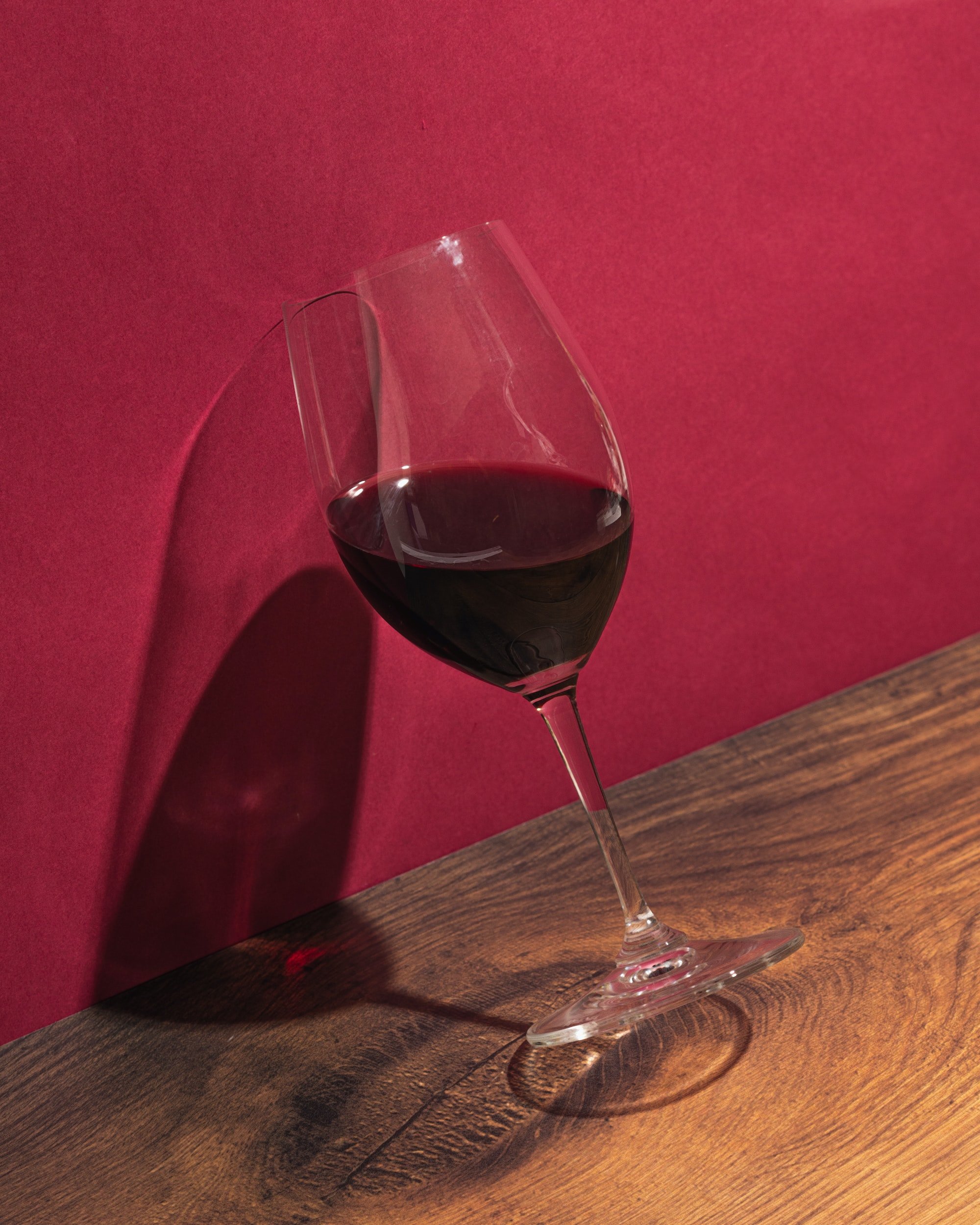
If you’ve discovered that red wines are a little harsh for your personal tastes and hard to swallow, then look for widely-sold, mainstream red wines at the $15 and below price point.
Why Red Wines with Sweetness Are Good for Beginners
Confession: I started my red wine journey with slightly sweet red wines. This off-dry wine style helped nudge me along in my journey and may be the perfect choice for you, too. Affordable and friendly. My kind of wine date!
Another obvious way to tell if the wine you’re holding is sweet is to see if the label has context clues (again), like:
- Does the label include a sweetness scale? These little line scales are super-helpful for new wine drinkers.
- Does the label include words like off-dry or medium-dry? Then the wine has a little sweetness in it (despite the word ‘dry’).
- Does the wine name use words like cake or jam? Names that convey confection or pastry will probably be slightly sweet.
Okay, those are the 3 key parts of any red wine for beginners that you need to know about. Let’s talk about the actual wines.
What’s a Good Red Wine for Beginners?
The #1 most important step you can take to choose a good red wine for beginners is to focus on the grape type.
Don’t worry about the different growing regions and don’t worry about choosing a wine from a particular winery or winemaker.
Helpful Tip: Go check out this post on how to find affordable wines for beginners with tips to save you money (I put this together just for you if you’re getting started.)
Why do you need to focus on the grape type?
Every kind of red wine grape (like Pinot Noir or Zinfandel) has a certain profile. No matter where the grape’s grown or who makes the wine or what the wine’s called, that profile stays the same. Yes, it will change ever so slightly, but the wine’s style will remain true to its origins.
Don’t want to worry about a particular red wine from a certain producer as a beginner.
Why not? Here in the US, but in other markets as well, alcohol’s strictly regulated and distribution is maffia-level complex. Seriously. This means that the wines that I can get in my local market will be different than the wines that you can get in your local market.
So, it really doesn’t make a ton of sense to go searching a certain label for beginner red wines, especially if you’re not even sure what you like yet.
INSTEAD DO THIS: Focus on learning about the different profiles of red wine grapes.
Ready to get started? Here are six good red wines for beginners. I’ve put them in the order that I would recommend to a red wine beginner.
A Good Red Wine for Beginners #1 – Pinot Noir
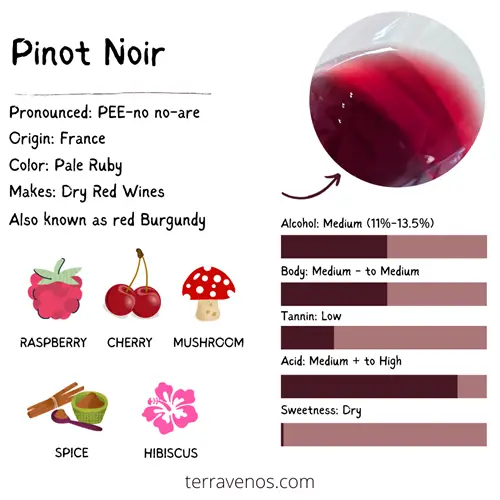
Pinot Noir’s one of the best red wines for beginners because the wine’s approachable on every level. Pinot profiles bright red cherry and strawberry and often warm baking spice thanks to oak. Pinots have a medium body, meaning that they’re typically mid-level on the alcohol scale and easy-drinking wines that you can enjoy as a cocktail or with your meal.
Helpful Tip: If you’re just getting started, head over to this post that covers the primary winegrowing regions around the world and their main grapes.
Pinot Noir doesn’t have high tannin. The grape has thin skins, making this the perfect beginner red wine if you’re not into saliva-sucking dry reds.
Expect entry-level Pinot Noirs from big producers to have a little sweetness in them. Pinot Noirs from small producers will always be dry.
But, because of that bright fruit, you’ll probably be tricked into thinking the wine’s sweet.
I love Pinot.
Pinot Noir’s grown around the world. The spiritual home of Pinot Noir is Burgundy, France. Look for ‘Red Burgundy’ on a bottle of wine. Or just the word ‘Burgundy’ and then peer into the bottle to make sure it’s red. You’ll be holding a classic Pinot.
Helpful Tip: Go check out this post that will help you figure out how to read a wine label.
Other places that grow scrumptious Pinot Noir are Sonoma, Monterey, Oregon, and Central Otago (New Zealand).
A Good Red Wine for Beginners #2 – Grenache

Grenache, like Pinot Noir, delivers a red cherry, strawberry, and black plum flavor profile. Expect Grenache to come in two distinctive styles: light and fruit-forward, or fuller-bodied with leather and layers of depth.
Most Grenache wines don’t have high tannin levels but fall somewhere in the middle. Softer tannins can make Grenache a better red wine for beginners.
The winemaker decides how to craft the wine to make either style of Grenache. This means you’ll want to taste several bottles of Grenache from different producers to appreciate the wine’s stylistic range.
Oh, the burden!
Helpful Tip: Here’s a complete guide to Grenache wine.
Grenache needs a long, hot growing climate to fully ripen. This means you’ll find Grenache wines from sizzling lands.
The grape is originally from northeastern Spain, so look for Garnacha (the Spanish version of Grenache – same wine, same, grape, don’t be confused). An added bonus is that Spanish wines are undervalued, so you’re going to discover some excellent affordable bottles.
From Spain, Grenache crossed the border and moved up the Rhone Valley, so you’ll find Grenache from the Southern Rhone, like Gigondas, St. Joseph, and Châteauneuf-du-Pape.
This region has a tradition of blending red wines, so you may find 100% Grenache wines, or it may be a Grenache-based blended wine.
You’ll find California Grenache from Sonoma, Napa, Santa Cruz, Monterey, and Paso Robles. You’ll also find grown in Southern Oregon and Eastern Washington.
A Good Red Wine for Beginners #3 – Malbec

Malbec is often overlooked as a good go-to wine for beginners, but it’s actually quite perfect. Malbec has velvety medium tannins, a medium body, and delivers rich blueberry, blackberry, cocoa, and baking spice.
What isn’t to love?
Malbec will have medium to high alcohol levels, depending on the grapes that go into the wine.
Helpful Tip: Check out this post on Malbec’s quirky backstory and how it rose to become Argentina’s flagship wine, launching the country to international acclaim.
In the US, most Malbec comes from Argentina. The country has a special history with Malbec and today, thanks to favorable exchange rates, you can find amazing bottles of Malbec wine for a fraction of what a similar quality bottle from California will cost you, so make sure you try some Argentinian Malbec.
You may find Malbec from France, under the regional label of Cahors AOC. This area’s just southeast of Bordeaux and has a moderate climate. Malbec from Cahors AOC will have higher levels of raspy tannins, to just be prepared if that’s the wine you decided to buy.
Quick Tip: A fun experiment is to do a side-by-side tasting of 1 bottle of Malbec from Argentina and 1 bottle of Malbec from Cahors AOC. This experiment will reveal the range of Malbec.
If you’re in the US market, you will find Malbec grown around California and it’s becoming an important grape in Washington State, too.
A Good Red Wine for Beginners #4 – Merlot
At one point in time, Merlot was the most popular red wine in the US. Tastes and trends change, and today, while still crafting beautiful, silky reds, you don’t hear a lot about Merlot among wine aficionados.
In fact, here’s a Merlot label that I ran across in my local bottle shop (bear added for effect):
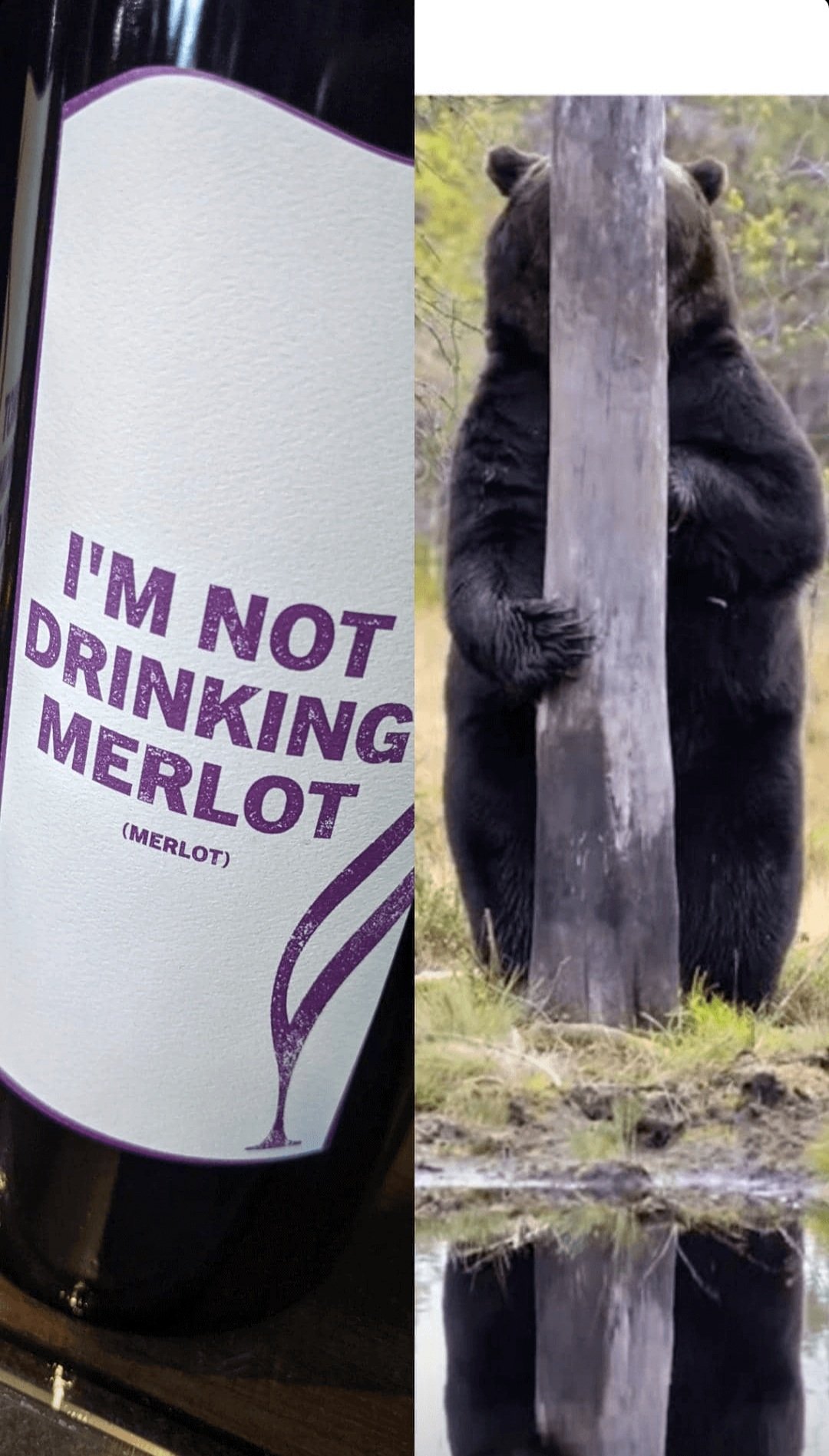
But Merlot’s a perfect red wine for beginners. Merlot delivers rich black plum, black cherry, and smooth medium tannins that don’t bite back.
Expect Merlot wines to have a well-balanced, medium body that just feels pleasing in your mouth.

In US markets, you’ll find Merlot grown throughout Napa, Monterey, and Paso Robles, as well as the Central Valley. It’s often used in red blend table wines that don’t list the grapes. You’ll also find Merlot from southern Oregon and eastern Washington.
Helpful Tip: Check out this post that covers where Merlot is grown around the world and it’s different styles.
Look for Merlot from France under Bordeaux labels, specifically Right Bank appellations where Merlot plays a dominant role. Bordeaux wines are a little complicated for beginners. It’s a French wine thing in general. The best advice for beginner red wine drinkers is to go to a local wine shop and ask for a “Right Bank Bordeaux”.
You’ll also discover amazing Merlot wines from Chile, which will be affordable and technically well-made. Chilean Merlots are a perfect way to start tasting Merlot if you have access to them because they’ll be affordable and showcase the grape’s signature qualities.
A Good Red Wine for Beginners #5 – Zinfandel

Zinfandel, or Zin for short, originally comes from the southern regions of Italy, where it bakes in the Mediterranean sun. Back in Italy, the grape goes by Primitivo with extensive plantings throughout Puglia, the boot part of Italia.
Given Zin’s origin story, it’s no surprise that this inky black grape thrives in the brutal summer suns of inland California.
What does Zinfandel taste like?
This full-bodied, strong red wine brings the full spectrum of black and red fruits – from blackberry and black plum to raspberry. Expect these fruits to be jammy and even dried given that the grapes need to sit in the vineyard until fully ripe, soaking in all that sugary sunshine goodness. Zinfandels do well with oak, so you’ll find cinnamon, cocoa, and warm baking spice in your wine. Zinfandels have firm tannins on the upper end of the scale. Low alcohol Zin from Lodi starts at 14% ABV, and most Lodi Zins will be 15% ABV and higher. Drink slowly!
Helpful Tip: Here’s a complete guide to Zinfandel wine.
What Zinfandel should you buy?
If you’re in the US, you’ll find California Zinfandel at any wine store. Pick a bottle around the $10-$15 range and you’re going to experience a wine powerhouse. If you want a more specific recommendation, look for a Zinfandel from Lodi, the home of old-vine Zinfandel.
The region known as the spiritual home of old-vine Zinfandel in California is Lodi.
Helpful Tip: If you see ‘old vine’ on a wine label, you should know that it’s not a regulated term. Unscrupulous wine producers can stick the ‘old vine’ phrase on their labels, regardless of the vine’s actual age. Here’s a helpful post on ‘old vine’ wines and why they’re special, if they are, in fact, old vines.
If you’re outside of the US or looking for a unique Zinfandel, try to find an Italian Primitivo.
A Good Red Wine for Beginners #6 – Cabernet Sauvignon
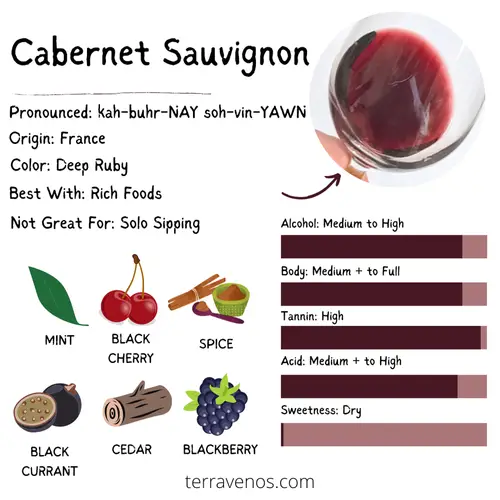
Cabernet Sauvignon, or Cab Sav, makes the list as a good wine for beginners, but it’s at the very bottom of the list.
Why, you might ask, is Cabernet Sauvignon at the bottom of this list given that it’s such a widely made and popular wine that can sell for hundreds of dollars?
Excellent question.
Answer: Cabernet Sauvignon grapes are full-bodied and high in tannin and acid with black currant, mint, dark chocolate, and toasty smoke. If Cabernet’s underripe, that minty quality actually tastes like green bell pepper and many people (me included), don’t like green bell pepper in their wine.
Green pepper flavors in some Cabernet Sauvignon wines can be a turnoff.
Add to that, all of those high tannins don’t make Cab an approachable red wine for most beginners. But, Cabernet Sauvignon is a good red wine for beginners to know and become familiar with because you’re going to run into it. A lot.
Helpful Tip: Here’s a complete guide to Cabernet Sauvignon.
What Cabernet Sauvignon should you buy?
In the US market, I’d stick to widely-distributed Cabernet Sauvignons between $10 and $20. These wines will be technically well made and likely blend in grapes from different locations to minimize any under-ripe green flavors. These wines will allow you to develop a good baseline for what Cabernet Sauvignon tastes like.
From there, go explore Left Bank Bordeaux, South African Cabernet, Napa Valley Cabernet (of course), Super Tuscans, and Chilean Cabernet.
Cab reflects the growing climate, so taste widely from lots of different regions once you feel comfortable with the wine’s profile.
And…
If you decide that Cabernet Sauvignon is too strong for you and you’re not a fan, no big deal. The world’s full of other wine grapes just waiting for you to discover them!
Final Thoughts: What’s a good beginner red wine?

A good red wine for beginners helps you learn about different grape profiles.
These six wines are the best beginner red wines: Pinot Noir, Grenache, Malbec, Merlot, Zinfandel, and Cabernet Sauvignon. In that order.
Try several bottles of each wine and you’ll quickly figure out how each grape differs in its profile.
Thirsty for more?
There’s so much to uncork when it comes to wine as a new drinker, and I’m sure you have lots of questions! Here are two fun posts that are helpful wine lovers:



